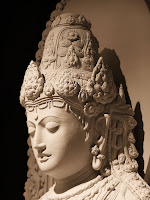Dhr. Seven, Amber Larson, CC Liu, Wisdom Quarterly; Sabrina, GoddessaDay.com
 |
Prajna Paramita, the feminine embodiment of the Dharma, literally the "Perfection of Wisdom" (a gift to Aranya Anandabodhi's Hermitage/AwakeningTruth.org) |
.
.jpg) |
| Perfect Wisdom personified |
There are ten "perfections" (paramis or paramitas) a bodhisattva ("being striving for perfect enlightenment") cultivates if s/he wishes to forgo a disciple's enlightenment for the supreme enlightenment of a non-teaching (pacceka) buddha or enlightenment with the ability to effectively teach and establish the true wheel of the Dharma in a world that has lost its way, a samma-sam-buddha.
The culmination of transcendental knowledge -- liberating insight that has transcended ego, suffering, and impermanence -- Prajna Paramita is the feminine “Perfection of Wisdom,” who gives birth to all buddhas.
Interestingly, the Goddess of Compassion, Kwan Yin (Guanyin), is much more famous. Both are essential elements of a supremely enlightened teacher's attainment.
Like Kwan Yin, she is sometimes depicted as having the many arms of an omnipotent Hindu goddess (devi), which is likely the largest influence on the rise of "goddesses" as prominent subjects of Buddhist reverence.
For the Vedic religion and subsequent Hinduism promote mono- and polytheism as ways of talking about ineffable subjects directly. There is just one GOD, Brahman, the Ultimate Reality behind the illusion of maya, which finds expression in many gods and goddesses.
So the root of all buddhas, in this way of thinking, is no ordinary deva but a superlative one: impersonal wisdom.
The strange back story of the tantric Taras suggests that "goddess" is more an honorific -- a divine-human hybrid appealing to warrior nobles like Prince Siddhartha and his fellow Scythians/Shakyians -- than specific to any distinction in knowledge-and-vision worthy of the noble ones.
These goddess-figures are usually shown holding symbols illustrating their role. Prajna Paramita is a teacher, so she is often depicted holding meditation beads (emblematic of the eternal cycles of time), a rope or magic lasso (like Wonder Woman's, to retrieve those who have strayed from the Path), fruit (for prosperity or path-and-fruition), a lotus (purity), a vase (abundance) and, most importantly, a book (knowledge or wisdom).
 |
| Uppalavanna (frank.itlab.us) |
In the Heart Sutra, the possessor of such wisdom is Avalokiteshvara, "the one looks down upon [and hears the cries of] the world."
He is taken to be or to have later been transformed into the merciful Kwan Yin (Mother Goddess, Mother Mary figure, a new Saraswati or Lakshmi), but the wisdom itself is Prajna (paññá).
What came first, the sacred texts or the goddess embodying them?
Other "goddesses"
 |
| Khema, foremost in wisdom (iwilliam/flickr) |
And little is said about the Buddha's two mothers, Maha Pajapati (Prajābatī, who became the first Buddhist nun in history) and his birth-mother Queen Maha Maya Devi.
Why are they rarely discussed? Likely due to sexism and neglect, the ancient Order of Nun (Bhikkhuni Sangha) the Buddha began as an essential element of his mission became defunct. And with that loss so went knowledge of discourses (sutras) delivered to nuns:
One never sees, "O, bhikkhunis!" as the opening of any sutra, yet it is certain the Buddha must have started many discourses this way. And there must have been other now lost discourse delivered by these two nuns to the female monastic community. For they were as important as the wonderful and well-known chief male disciples, Sariputra and Maha Moggallana, we read about all the time.
Nuns: an afterthought forced on the Buddha?
 |
| I raised Prince Siddhartha, my sister's son. |
"For the Blessed One, O venerable sir, spoke these words to me: 'I shall not come to my final passing away, Namuci, until my bhikkhus and bhikkhunis [monks and nuns or male and female wandering ascetics], as well as laymen and laywomen, have come to be true disciples -- wise, well disciplined, apt and learned, preservers of the Dharma, living according to the Dharma, abiding by the appropriate conduct, and having learned the Teacher's word, are able to expound it, preach it, proclaim it, establish it, reveal it, explain it in detail, and make it clear; until, when adverse opinions arise, they shall be able to refute them thoroughly and well, and to preach this convincing and liberating Dharma'" (Verse 7).
- ñána: "Knowledge, comprehension, intelligence, insight" is a synonym for paññá (Sanskrit prajna); see also vipassaná.
- ñána-dassana-visuddhi: "Purification of knowledge and vision" [knowing-and-seeing] is the last of the seven purifications and a name for path-knowledge (magga-ñána), i.e., the penetrating realization of the path of Stream-winning, Once-returning, Non-returning, and Arhatship [full enlightenment]. The Path of Purification (XXII) furnishes a detailed explanation of it; (see visuddhi, VII).


















































































































































































































































No comments:
Post a Comment